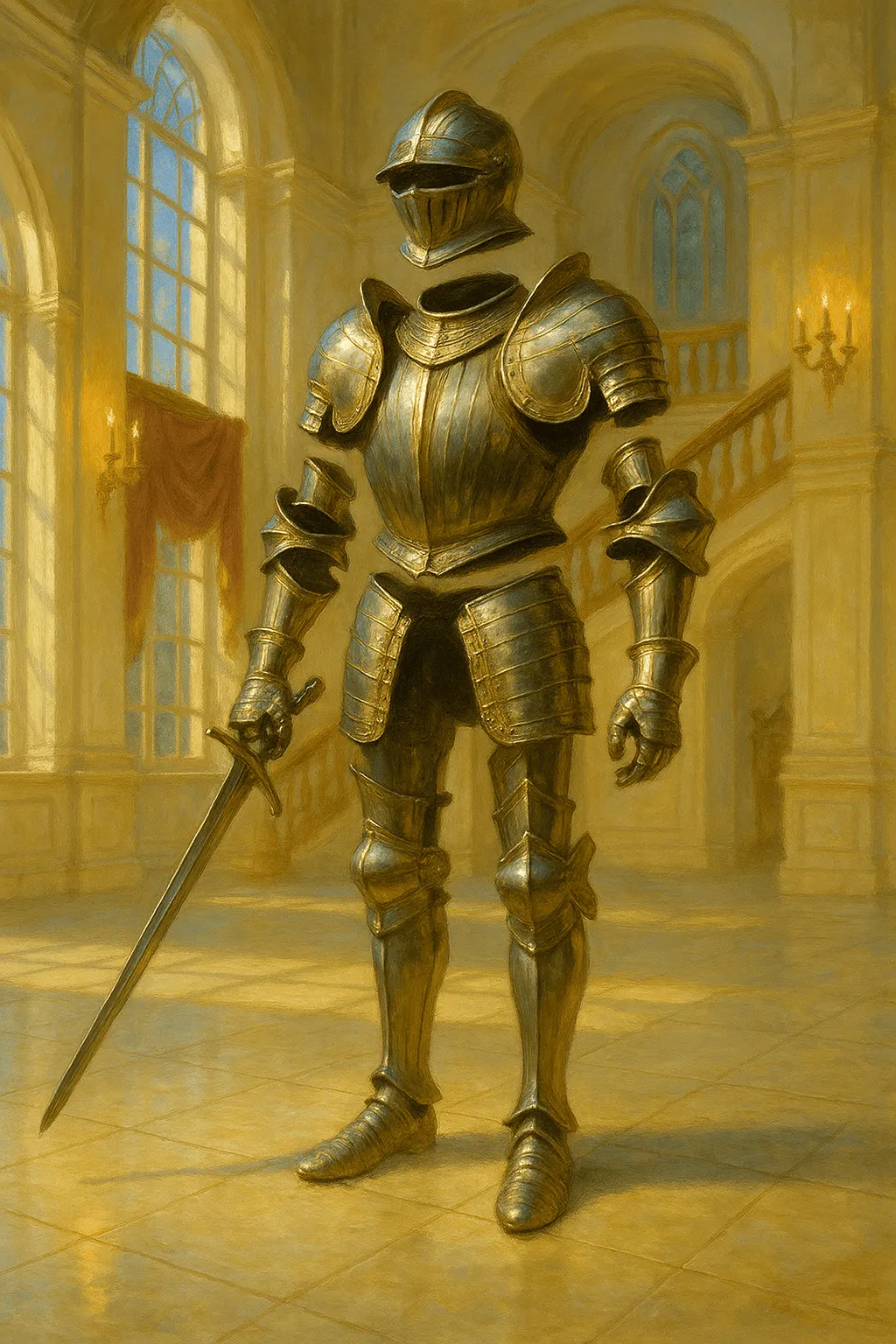
Steel endures where memory fails
In the deep folds of forgotten history, not all warriors found peace in death. Some, through willpower, duty, or forces unknown, transcended the decay of flesh. Their spirits, unwilling to move on, bound themselves to the very armor they wore into battle. These are not simple enchantments or tricks of magic—they are the Living Armors: vessels of memory and purpose, persisting across centuries.
 While many suits of armor throughout history have been enchanted or animated through arcane means, not all animation is equal in nature or origin. Most conjured or spellbound armor is a product of deliberate magical construction—a hollow vessel, commanded by a mage, ritual, or latent enchantment. These creations, while often formidable, are fundamentally tools: lifeless, voiceless, moved only by the will of their creator.
While many suits of armor throughout history have been enchanted or animated through arcane means, not all animation is equal in nature or origin. Most conjured or spellbound armor is a product of deliberate magical construction—a hollow vessel, commanded by a mage, ritual, or latent enchantment. These creations, while often formidable, are fundamentally tools: lifeless, voiceless, moved only by the will of their creator.
Living Armor, by contrast, represents a far rarer and more mysterious form of animation. It is not created—it becomes. In these rare instances, a soul, upon death, does not leave the armor behind. Instead, bound by love, vengeance, duty, or sheer force of will, the spirit anchors itself to the armor that bore it in life. The resulting entity is not merely animated, but aware. It moves of its own volition, guided by lingering purpose or fragmented memory. Some call this a curse, others a miracle.
 This distinction is crucial: all Living Armor is animated, but not all animated armor is living. The difference lies in the presence of self—of memory, of resistance, of choice. Where conjured armor obeys, Living Armor endures. Living Armor, by contrast, is self-willed. It carries the echo of a soul within the hollow plates, a lingering consciousness that chooses, resists, or endures.
This distinction is crucial: all Living Armor is animated, but not all animated armor is living. The difference lies in the presence of self—of memory, of resistance, of choice. Where conjured armor obeys, Living Armor endures. Living Armor, by contrast, is self-willed. It carries the echo of a soul within the hollow plates, a lingering consciousness that chooses, resists, or endures.
Not all armor can bear a spirit. The phenomenon of Living Armor is rare, and when it occurs, it is often born from profound emotional forces. Some warriors are bound by oaths unfulfilled, knights who swore to protect a kingdom that fell or guardians who could not save those entrusted to them. Others are driven by love and loyalty, warriors unwilling to leave behind family, comrades, or sacred vows. There are those consumed by vengeance and hatred, spirits so lost in rage that death could not still them. In rarer cases, suits of armor were deliberately crafted to act as vessels for willing souls, though such rituals border on the darker arts. Some armors absorbed the ambient magic of cursed battlefields or ancient ruins, causing the spirit's bond to solidify long after death.
 Living Armor is sentient. Some retain fragments of their former personalities, while others operate more on instinct, guided by remnants of purpose. Silent Guardians remain in the ruins where they fell, standing eternal vigil. Wanderers drift across the world, searching for redemption, forgotten comrades, or the final peace that eluded them. Some Living Armors may fall under the sway of strong magical forces, yet the binding is imperfect; given the chance, they may resist or break free. Though they possess no voice, Living Armors communicate through action—offering protection, drawing swords, barring paths, or standing impassively as a warning.
Living Armor is sentient. Some retain fragments of their former personalities, while others operate more on instinct, guided by remnants of purpose. Silent Guardians remain in the ruins where they fell, standing eternal vigil. Wanderers drift across the world, searching for redemption, forgotten comrades, or the final peace that eluded them. Some Living Armors may fall under the sway of strong magical forces, yet the binding is imperfect; given the chance, they may resist or break free. Though they possess no voice, Living Armors communicate through action—offering protection, drawing swords, barring paths, or standing impassively as a warning.
 Across cultures, the manifestation of Living Armor varies greatly. The Hollow Knights, encased in battered Western plate, guard ruined cathedrals and silent battlegrounds. The Wandering Samurai, clad in o-yoroi and do-maru, float through misty forests with silent dignity. The Warlord’s Remnant, heavy piecemeal armor from tribal lands, walk the lonely steppes where great clans fell. Ceremonial Sentinels, gilded suits adorned in robes and tokens of forgotten empires, linger in once-sacred halls. In every case, the armor floats apart slightly—helmet detached from the chest, gauntlets hovering free—a constant, eerie reminder that no living body remains inside.
Across cultures, the manifestation of Living Armor varies greatly. The Hollow Knights, encased in battered Western plate, guard ruined cathedrals and silent battlegrounds. The Wandering Samurai, clad in o-yoroi and do-maru, float through misty forests with silent dignity. The Warlord’s Remnant, heavy piecemeal armor from tribal lands, walk the lonely steppes where great clans fell. Ceremonial Sentinels, gilded suits adorned in robes and tokens of forgotten empires, linger in once-sacred halls. In every case, the armor floats apart slightly—helmet detached from the chest, gauntlets hovering free—a constant, eerie reminder that no living body remains inside.
Living Armors inspire awe, fear, and reverence. Villagers sometimes raise shrines to a silent guardian, leaving offerings of oil, cloth, or simple prayers. Scholars and mages seek them out, desperate to understand the mystery of spirit-binding. Tyrants try to capture or enslave them, forging enchanted shackles to bend them into service. Children whisper of the "Ghost Knights" who might save—or punish—those who venture too far from home. Yet Living Armor follows its own will. Attempts to command them are fraught with peril.
 The Living Armor is not a creature of malice or mercy—it is a vessel of memory, a fragment of will suspended against the tides of time. Some may find peace through acts of redemption. Others may rage until the plates themselves crumble to dust. But wherever they go, the world remembers:
The Living Armor is not a creature of malice or mercy—it is a vessel of memory, a fragment of will suspended against the tides of time. Some may find peace through acts of redemption. Others may rage until the plates themselves crumble to dust. But wherever they go, the world remembers:
"There walks the past, clad in hollow steel, unburdened by flesh, yet heavy with purpose."
The following magical heirlooms are fictional and lore-based in nature. Each one is an affiliate link to a real-world item on Amazon that we've hand-selected to complement this artifact's lore.


If you click a link and buy an item, we may earn a commission.It costs you nothing extra, but can help keep this little corner of the internet glowing.
What does this mean?
A tireless guardian woven from spellcraft and will — silent, watchful, and unwavering at its post.

Fire without the fuss! Perfect for bardic storytelling.

Your own loyal bodyguard, skilled not just with the sword but pen as well.

Sharp enough to fell any tree, wise enough to ask which ones.





